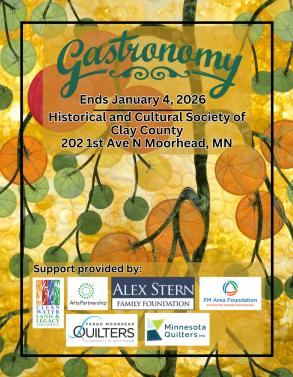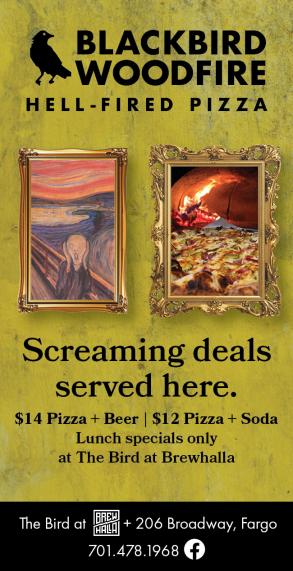Cinema | March 12th, 2023
By Greg Carlson
gregcarlson1@gmail.com
New York City-based director Emily Sheskin’s work has been featured in “The New York Times,” “The Atlantic,” and “National Geographic,” among others. In 2017, Vimeo named Sheskin one of “ten groundbreaking women in film to watch.” Previous commercial clients include Disney, Microsoft, and Pokemon.
The director’s cut of her NYT Op-Doc featuring boxer Jesselyn Silva was a Vimeo Staff Pick that played in numerous film festivals, including the Fargo Film Festival. A few weeks ago, the feature-length version of Silva’s story, “JessZilla,” premiered at the Big Sky Film Festival in Missoula, Montana.
“JessZilla” is the opening night movie of the 2023 Fargo Film Festival, screening on Tuesday, March 21 at 7 p.m. at the Fargo Theatre. Director Sheskin and producer Ben Kainz will answer audience questions and share conversation following the film.
Greg Carlson: How was the “JessZilla” world premiere at Big Sky?
Emily Sheskin: It was great. A lot of fun. But by the end, my body said, “No more! Shut it down!”
GC: I love Missoula and I love that festival.
ES: I had only been to Glacier, so it was great to visit another Montana spot. It was cold, though. Negative twenty at one point, which I didn’t love. Other than the temperature, pretty awesome. We showed the movie to a class of 16-year-olds, and that was one of the highlights of the trip.
GC: Where did you grow up?
ES: I grew up in Bethel, Connecticut. When you live in New York City, people identify Connecticut as a place where wealthy people reside, but my town was pretty blue collar. My parents were teachers. My mom taught art to elementary school kids and my dad was a professor of abnormal psychology. He wrote a statistics book, but he was also an artist who painted.
GC: Did the family interest in art take hold of you at an early age?
ES: Definitely. I thought that going on vacation meant visiting art galleries. And maybe getting ice cream. My dad also writes, so storytelling was something that we did together. There was a program called Child’s Play that came to my school when I was in the second grade. They were improv performers who would select a story written by one of the kids and act it out.
My friend Adam and I entered a story about a Tyrannosaurus rex whose sister signs him up for a cooking contest. The T-Rex is sad, though, because he doesn’t know how to cook. Fortunately, he meets a singing fish who gives him a great recipe. The T-Rex ends up winning the cooking contest and the grand prize is a Brontosaurus. The climax is the T-Rex ripping the Brontosaurus to shreds.
GC: Wow.
ES: Our story won! And Adam and I thought, “This is going to be so sweet! Do you think they are going to use fake blood for the ending?” But the improv actors re-wrote our ending to the T-Rex being told, “You’ve won a new best friend!” Adam and I were outraged.
It was the moment I became disillusioned. I realized that if you want something done, you’ve got to do it yourself.
GC: How does the transition to telling stories on film/video happen?
ES: I begged for a video camera in high school. I came to it kind of late compared to some. I was 16 years old and it was a Mini-DV camcorder. My school had a very basic, bare-bones AV club, but I was lucky it existed.
GC: What did you make?
ES: I got obsessed with animation, but I wasn’t the best artist. I think the combination of being into theater and having grown up with storytelling naturally led to film. I got my friends to act in the scripts I wrote. I originally went to NYU for theater but quickly switched to film and TV.
GC: What was the most valuable thing you learned at NYU?
ES: You don’t need to go to film school to be successful, but what film school gave me was an incredibly supportive and inspiring network. If you are surrounded by like-minded people who are motivated and interesting and funny and smart, then you are on the right path. The friends I met at school turned out to be the greatest asset I could have received. And those relationships extended beyond film school.
GC: When you were at NYU, what did you imagine things were going to look like out of school?
ES: Post-graduation, I was realistic. I am not from a rich family. Some of my classmates were Los Angeles-connected. Royalty types. But that was not me. So I was very clear about asking myself how I would make a living. I landed at College Sports Television, which is now CBS College Sports. I was a paid intern and that’s how I got my first job as a motion graphics artist, which is nothing like what I thought I would be doing.
But the people were really generous. They taught me how to use After Effects and Photoshop. So I thought I might end up being an editor to pay the bills. An editor who makes movies on the side. I basically did that for ten years. Editing in the commercial space. It was always short form. I liked being hired for a couple weeks and then moving on to something else. That worked for me. It allowed me to split my time between the work I did for others and the work I did for myself.
GC: What happened next?
ES: I promised myself I wouldn’t take another staff job but I met some people at a company that no longer exists. They were very cool. I told them that the only way I would take the edit job was if they would give me the opportunity to direct. They did not promise anything but they ended up making good. From there, I built a small commercial reel and when the New York Times Op-Doc came out, people could see that I had commercial experience that made me more employable.
GC: I see an intersection between your commercial work and your artistic sensibility. Like the Galaxy’s Edge stuff.
ES: That was so much fun. Disney has been a great client. When you grow up loving Disney IP, the fit is an easy one. I pitched an idea about Star Wars superfans going to see Batuu for the first time. I rewatched all the Star Wars movies. I looked at the kinds of framing that Lucas used in the original. And then I thought about the way that J.J. Abrams rebooted it.
I wanted to use the cinematic language of Star Wars in my work. Like a hybrid of the Star Wars language that we already know combined with documentary storytelling. That park is so awesome. Anywhere you pointed a camera made a composition that looked like you were on a movie set.
Usually in documentary I am fighting with the location to get the perfect shot. This was, “Looks great! Oh, and this looks perfect, too! And this angle also looks amazing!”
GC: You’re part of the Star Wars filmmaking universe!
ES: It was a lot of fun. You try to find the right style of communication demanded by the subject. For “JessZilla,” I had to think about the language of boxing movies. So I could honor it and play with it and disrupt it. I also wanted to interject Jess as a kid, a girl – and respect her femininity – while still keeping some of the boxing stuff that people are familiar with.
GC: I recently watched “Creed III.” I loved how Michael B. Jordan used his longtime passion for anime to construct some of the ring choreography, even down to specific punches.
ES: Awesome. I am so excited to see the new one and what Jordan does. I also think Ryan Coogler is an incredible director. He did such a fantastic job with the first “Creed.” “Black Panther” is so good. He just builds the best sandcastles in the sandbox.
GC: What is the signature Emily Sheskin touch you like to use in your moviemaking?
ES: When I redid my website, I watched some older work and realized that I am drawn to people who stay optimistic in very difficult situations. People who see the good in struggle. As a director, my strength is in the conversational interview. When you watch something I made, you can see that the people are comfortable and want to be there.
GC: Concern for the comfort of on-camera subjects reminds me of my friend Mike Scholtz.
ES: I love Mike! I just talked to him.
GC: I know you were into theater as a kid, but were you also into movies?
ES: Absolutely. I watched all kinds of stuff, including art movies. Bethel Cinema was the art house in our town. I remember seeing Almodovar’s “Talk to Her” when I was 17 and thinking, “Oh, shit. This is what a movie can be.” I got a real introduction to cinema there.
When I was in high school, “American Beauty” was one of my favorites. I won’t rewatch it because I know it probably won’t hold up to the power of my memory. My adult self could not possibly like it as much as my teenage self. When I saw the scene with the rose petals, I was compelled to look up the cinematographer. I then tracked down every movie that Conrad Hall photographed so I could study his path to greatness.
GC: “In Cold Blood.” “Cool Hand Luke.” “Butch Cassidy and the Sundance Kid.” Brilliant. Did you keep a collection of movies?
ES: I did. And those movies had so much to do with my taste at the time. Growing up as a young woman in the 90s, it was rare for me to recognize myself on the screen. At that time, there was nowhere near the inclusiveness and representation that we have today. And we still have such a long way to go.
So when I saw movies like “Clueless” and “Big” and other movies directed by women, I naturally gravitated to those stories. But I had other favorites, too. “Ladybugs” is still hilarious even if it does not entirely hold up. I love “Heart and Souls” with Robert Downey Jr. It played on TBS all the time. So I went for ridiculous comedies and schmaltzy romances that weren’t embraced by critics.
GC: How did the films you watched when you were growing up inform the way you approach moviemaking?
ES: I think movies should be entertaining. And my philosophy is that movies should be for everybody. I am less inclined to like movies made only for people who understand movies. For example, I tried to model “JessZilla” after the Pixar approach. One of my screenwriting professors cited “Finding Nemo” as a perfect script. Parents relate to Albert Brooks and kids relate to Nemo. Two segments of the audience are captivated. One movie. Two perspectives.
When we were making “JessZilla,” I thought about “Finding Nemo.” Parents ask questions about Pedro, or through a parental lens. But kids who see it want to know more about Jess.
GC: The amount of time you have spent with Pedro and Jess reminds me of Linklater’s “Boyhood” or Kubrick’s idea to shoot over many years with the same kid. The revelation of the diagnosis, which you decided to include in the trailer, is devastating.
ES: I will say that we obviously never expected something like that to happen. For Jess and for everyone, it was an absolute nightmare. Pedro was a wreck. I was a wreck. Jess received the diagnosis and soon after that I talked to Pedro about the best way to be supportive. For the grown-ups, more filming was not on the agenda. Jess was the one who wanted to continue shooting.
Pedro wanted her to have a sense of normalcy, especially in the days following the diagnosis. He asked me how I felt and I said that we needed to talk to Jess. Grown-ups might make decisions, but Jess was in control. Her voice needed to be heard and respected. For her to say that she wanted to tell that part of the story … I thought, “OK, we are not making the film that I thought I was going to make.”
GC: How did the impact of that change alter your approach to the movie?
ES: We are in a time where we think a lot about ethics in documentary filmmaking. Whose story is it? Who is telling the story? Most directors have good intentions. I am aware that I am not a member of the community to which Jess and Pedro belong. But I felt kinship with Jess because I saw a girl who wanted to make it in a male-dominated sphere.
There is a moment in the film where Jess cries because she feels like she is letting down her great-grandfather. It was a solo interview but Pedro comes into the frame and hugs her and asks me whether it is alright for him to sit with Jess in the shot. He puts his arm around her, looks at me, and says, “Ask your question.”
GC: I know exactly the moment.
ES: It is powerful to me because it illustrates that I am in charge but I am not really in charge. They are in charge. It was like they were communicating: “This is how we want to do it. I’m going to be here with her.” I hope that those moments reveal the kind of relationship that I have with this family and how important the ethics of telling a story like this were to me.
There is another moment where I ask Jess – after a loss – if she plans to give up. She says, “That’s a crazy question, Emily!” Kind of laughs at me. But then she composes herself and goes into interview mode and says, “I am not going to give up. I would like some redemption.” Those glimpses behind the curtain give an understanding of this relationship that grew and changed over the years.
GC: The love and respect.
ES: That has been the goal.
January 19th 2026
January 12th 2026
January 5th 2026
December 29th 2025
December 29th 2025
__293px-wide.jpg)
__293px-wide.jpg)



_(1)__293px-wide.jpg)